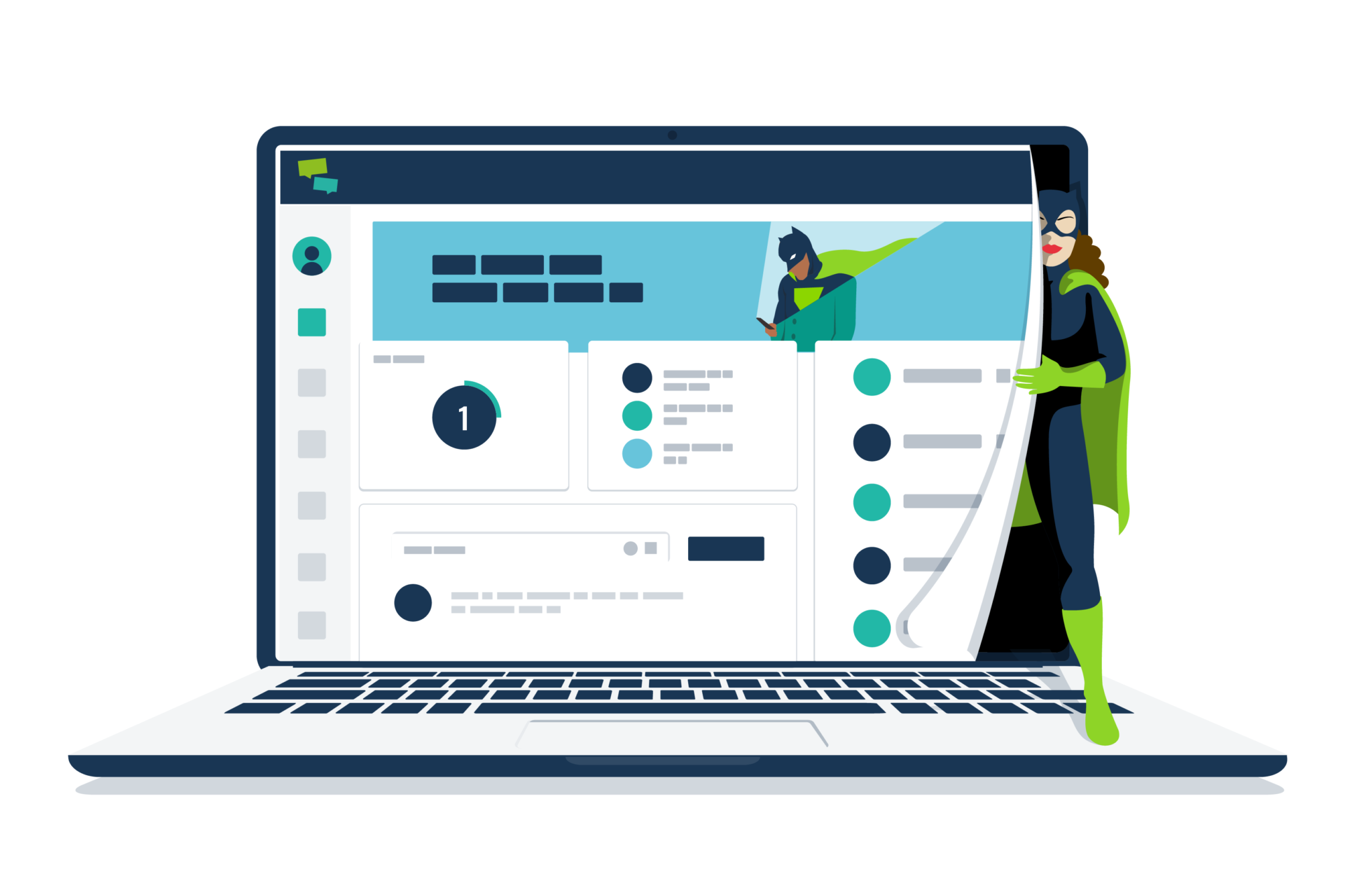Thanks to advancements in technology, we now have access to near-infinite capabilities at our fingertips. It’s only natural that this would impact the way we deliver instruction to an audience.
Technological innovation, combined with the recent switch to digital learning environments (think back to March 2020, everyone), VILT is one of the fastest-growing approaches in the online learning space. Today, organisations and educational institutions alike are embracing VILT.
But what exactly does virtual instructor-led training mean, and what are the benefits? In this article, we’ll do a deep dive into the fascinating world of VILT.
Without further ado, let’s go!
What is VILT?

VILT is an acronym for virtual instructor-led training. It’s a learning method where the instructor and learners are physically in separate locations and meet in a virtual environment.
As such, the instructor provides training to their learners in a remote, virtual setting. This virtual environment is designed to simulate a traditional instructor-led classroom or learning experience, even though the communication happens entirely through the cloud.
VILT can be summarised by the following characteristics:
- Real-Time Training: Learners participate in live sessions and in real time, just as they would in a face-to-face classroom session.
- Synchronous Learning: Despite joining remotely, learners participate in their training at the same time as other learners and the instructor.
- Collaboration: Learners collaborate with their instructor and peers through a digital platform or software.
The Benefits of VILT
1. Reduced Costs
Due to the virtual nature of VILT, learners access training from remote locations. As a result, organisations can reduce costs related to travel, facilities, catering and more.
As such, the online learning element makes VILT a more cost-effective approach compared to in-person instructor-led training. While you still need software that comes with a bigger initial set-up cost, online training is often more cost-effective over time.
Similarly, you can benefit from the knowledge of industry-leading subject matter experts from around the world without having to pay for expensive travel or accommodation costs.
2. Convenience
Inconvenient training is guaranteed to lower engagement levels. After all, carving out time to commute and participate in lengthy seminars is not always feasible.
Luckily, VILT is an excellent way to increase convenience and accessibility. There’s no need for your learners to commute anywhere (unless it’s over to their desks). And you can support your virtual classroom sessions with other online resources and content.
As such, you get the convenience of online training combined with the opportunity to interact with instructors in real time. That sounds like a winning combination to us!
3. Streamlined Processes
Recent advances in technology have made VILT easier than ever before. Modern software streamlines the process of creating and managing VILT sessions.
After all, these digital platforms allow you to manage the whole training process in just a few clicks. As such, you don’t have to rely on hiring additional administrators or infrastructure, printing out materials or organising instructor accommodation.
Similarly, you can create, deliver and evaluate training in one key platform, rather than having a separate tool for each aspect of your training delivery. These advantages increase training efficiency and streamline your processes.
4. Global Connectivity

Virtual learning has revolutionised the way people seek or receive new information. After all, learners can access training wherever they are rather than having to go to a set location.
This, of course, means that VILT has the power to connect learners in different cities, countries and continents. Digital tools, like instant translations, help organisations to create a globally connected learner audience that can share knowledge and learn from each other.
In addition, these learners come from varying backgrounds and cultures, enriching the learning experience. As a result, learners are exposed to different cultures, customs and religions, which leads to a more diverse learning environment.
5. Learner Engagement
Considering all these other benefits, such as increased accessibility and opportunities for connecting with peers globally, it comes as no surprise that VILT can lead to increased learner engagement.
Similarly, many VILT programmes offer supporting training content in the form of short microlearning units. These are quick and easy to complete, so that even the busiest learners can fit some training in.
As such, VILT is a good match for busy professionals who still prefer instructor-led training. They can take control over their training approach, whilst seeking out the help, support and guidance they need during these instructor-led sessions.
The Disadvantages of VILT
Virtual instructor-led training comes with vast benefits, but there are also some disadvantages to the approach:
- Digital Fatigue: Employees, learners, and customers alike are increasingly spending time online, which can lead to digital fatigue. As a result, our minds work in overdrive to process the overstimulation of fully digital experiences. This can prevent us from focusing and engaging to the fullest.
- Lack of Nonverbal Communication: Nonverbal communication and cues, such as eye contact, hand gestures, posture and facial expressions, help us to convey meaning and tell a story. Virtual environments limit how well instructors can express and access these nonverbal cues.
- Maintaining Engagement: In traditional face-to-face training, instructors can gain valuable insights from nonverbal cues. It can be difficult to comprehend how engaged your learners are within a virtual environment, especially if learners have their cameras turned off.
- Distractions: As training happens on the very devices we use to scroll the internet or social media sites, VILT may lead to distractions that deter learners from their training. Similarly, as learners experience training in a remote setting, they may be unable to control their environments and eliminate distractions.
- Limited Real-Life Applications: VILT provides limited options for in-the-moment, hands-on applications. As such, learners typically have to wait to put their new skills into practice.
What is the Difference Between Virtual Instructor-Led Training and eLearning?
Virtual instructor-led training and online learning are both methods of delivering learning experiences. They may seem similar due to their digital nature, but they have some key differences.
By now we know that VILT is a virtual training session that is led by an instructor in real time. As such, learners and instructors communicate and interact through video conferencing technology or other digital tools.
VILT sessions focus on replicating traditional in-person classroom sessions as closely as possible. While this approach is often used in combination with other methods, the instructor-led element is the key.
Online learning, on the other hand, refers to any form of learning that happens online through digital devices. This can include computers, laptops, smartphones, or tablets.

As such, whilst online learning happens in real time, it doesn’t necessarily involve an instructor. Instead, learners can explore content and continue their personal development journey in self-paced learning environments.
This makes these two approaches complementary. Most organisations combine VILT with online learning. After all, both approaches take advantage of online virtual environments that enable better accessibility.
Virtual Instructor-Led Training Use Cases
Virtual instructor-led training has a variety of use cases. In fact, organisations use it to provide training materials to employees, partners or customers. Educational institutions, too, can take advantage of VILT and educate students on demand.
However, let’s dig a little deeper. Here are some examples of how you can use VILT:
- Corporate Training: Organisations can use VILT to provide training for their employees on various topics, such as product knowledge or compliance. As such, organisations use the approach to provide continuous learning opportunities or certification courses that allow employees to upskill and reskill.
- Professional Development: VILT is an excellent way to improve one’s knowledge through qualifications or external training sessions. After all, it makes it convenient for individuals to attend training in their free time.
- Customer Training: VILT helps you to get customers up to speed with new developments. Similarly, you can host virtual sessions to help them master your products or services.
- Sales Support: You can use VILT to conduct product demonstrations or webinars for potential customers. This allows them to learn about the features and benefits of your offerings before making a purchase.
- Virtual Classrooms: VILT is also a useful addition to online learning initiatives as students or employees can attend classroom sessions remotely and interact in real time.
- Language Learning: Learning new languages is often easier when you can speak and interact with a native speaker or qualified instructor. VILT enables this even in remote settings.
- Technical Training: Virtual instructor-led training sessions create a simulated environment where you can deliver training on software, hardware or other technical topics.
Tools to Support VILT
To create successful virtual instructor-led training programmes, you need the right tools. While there are different ways to conduct VILT initiatives, your tool should provide features for comprehensive and scalable collaboration.
Similarly, VILT tools typically include features for live conversations, chats, polls and quizzes. These features are controlled and monitored by the instructors.
Let’s take a look at some of the different platforms available:
- Web Conferencing Software: Tools like Zoom, Google Meet or GoTo Meeting allow you to have real-time communication and collaboration with your learners by providing features for video and audio conferencing, screen sharing and chatting.
- Learning Management Systems (LMSs): This is where our expertise lies. LMSs, like Growth Engineering LMS, are software platforms you can use to create, deliver and manage online training.
- Virtual Classroom Software: Software for hosting virtual classrooms is specifically designed for VILT. As such, they’re the perfect fit for this type of approach.
- Virtual Reality Software: This type of software helps you to create virtual environments for training. While still a relatively new innovation, VR is becoming more popular in the L&D space as it provides immersive learning experiences.
- Simulation Software: Simulations allow you to create real-world scenarios for training purposes. This can be extremely useful in industries like aviation or medicine.
VILT Best Practices
If you have decided to take the next step towards implementing a virtual instructor-led training programme, there are some actions and best practices you should follow.
1. Strategy
Before you get started creating content or hiring instructors, you need to think through your VILT strategy. After all, virtual instructor-led training is typically part of a larger company-wide training plan that addresses the needs of each employee.
As such, you need to decide if your VILT sessions are part of a wider online learning approach, or if you wish to use it to create a blended learning initiative.
You can, for instance, use an online learning platform to provide content and a self-directed learning journey for your learners. They can then complete training and review materials autonomously before and after your virtual instructor-led session.
This kind of approach means that you don’t have to cram everything into marathon in-person sessions. Instead, your training content is broken down into smaller bite-sized pieces that your virtual classroom sessions reinforce with discussions and activities.
2. Content

VILT experiences require a unique approach when it comes to your learning content. After all, VILT sits somewhere between face-to-face classroom sessions and asynchronous online learning programmes.
With this in mind, instructional designers creating content for virtual instructor-led training must foster communication, engagement and collaboration. These elements should be front of mind throughout the design process.
Focus on visuals and interactivity to increase training effectiveness. Similarly, take advantage of your subject matter experts (SMEs) to create high-quality content.
3. Training Delivery
If you think back to your school years, we bet your favourite classes were led by a teacher who kept the lessons engaging and interesting. Even though technology has advanced a great deal, it cannot replace an enthusiastic and engaging instructor.
Indeed, many VILT initiatives are hampered by facilitation failures or a lack of engagement.
As such, to deliver compelling VILT, your facilitators need to be confident and skilled communicators. Whether they are teachers, trained instructors or subject matter experts, they need to master virtual interactions.
In addition, instructors need to know the software they are using inside out. This helps you to avoid all too common technical snafus that can hinder performance.
Virtual training delivery becomes much easier and more effective if you use approaches like narrative and compelling audio-visual content. Similarly, these sessions need to be interactive. Ask questions, incorporate group practices and vary your content formats!
4. Learning Culture
Your VILT will only become successful if you ingrain learning as a part of your organisational culture. And to do so, you should promote learning and personal development from the top down.
In fact, tying learning deep into your organisational culture is the key to success. After all, it helps you to keep engagement levels high as learning becomes a part of your employees’ routine.
As VILT means your training is fully or primarily conducted online, creating a flourishing learning culture may seem more difficult. But it’s not impossible!
You should utilise your digital tools to their fullest extent. For instance, your video classes, breakout rooms, chats and social streams all help you to create a tight-knit learner base.
5. Evaluation
Just like with any training programme, you need to track and measure the success of your virtual instructor-led training. After all, it’s one thing to implement a training initiative but it’s a whole other thing to make sure it actually works.
Your training platform can give you important insights into the effectiveness of your training. As such, you should track employee progress and assign necessary next steps accordingly.
In addition, ask for learner feedback during and after your training initiative. This helps you to adjust your training to ensure it’s useful for a wide variety of learning needs and skills gaps.
Final Words
Virtual instructor-led training has become a popular alternative to in-person training due to its flexibility and convenience. This guarantees its place in today’s digital world.
In fact, VILT is a great addition to typically asynchronous online learning. It enables organisations to offer their learners a comprehensive training experience that provides the best of both worlds.
Blending VILT and eLearning is an excellent way to create a comprehensive training programme that gives learners the opportunity to both explore content at their own pace and get support during instructor-led sessions.
Are you ready to supercharge your blended training programme? Make sure to check out our guidebook today!








